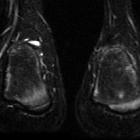calcaneal apophysitis










 nicht verwechseln mit: Knochenkerne Kalkaneusapophyse
nicht verwechseln mit: Knochenkerne KalkaneusapophyseCalcaneal apophysitis, also known as Sever disease, is the painful inflammation of the apophysis of the calcaneus.
Epidemiology
It typically presents in active young children and adolescents, especially those who enjoy jumping and running sports.
Associations
High plantar foot pressures are associated with Sever disease, although it is unclear whether they are a predisposing factor or a result of the condition. Gastrocnemius equinus may be a predisposing factor for Sever disease .
Clinical presentation
Patients tend to present with posterior heel pain, usually aggravated by physical activity such as walking, running, or jumping.
Pathology
The condition is thought to result from repetitive microtrauma to growth plates of the calcaneus. However, some of the recent literature states that there is a lack of evidence that weight and activity levels are risk factors for Sever disease .
Radiographic features
Sever disease is most often diagnosed clinically, and radiographic evaluation is believed to be unnecessary by many physicians, but if a diagnosis of calcaneal apophysitis is made without obtaining radiographs, a lesion requiring more aggressive treatment could be missed .
Plain radiograph
Foot radiographs are usually normal and the radiological identification of calcaneal apophysitis without clinical information is not reliable .
MRI
May show edematous changes within the calcaneal apophysis, possibly extending into the adjacent calcaneal tuberosity .
Treatment and prognosis
The condition is self-limiting with a brief limitation of activity sometimes being advocated. Standard advice is to reduce physical activity .
History and etymology
It is named after James Warren Sever (1878-1964), an American orthopedic surgeon, who first described it in 1912 .
Siehe auch:
- Apophysis calcanei
- posteriores Impingement am Sprunggelenk
- Haglund-Exostose
- dancer's heel
- Knochenkerne Kalkaneusapophyse
- hinterer Fersensporn
und weiter:

 Assoziationen und Differentialdiagnosen zu Apophysitis calcanei:
Assoziationen und Differentialdiagnosen zu Apophysitis calcanei:



